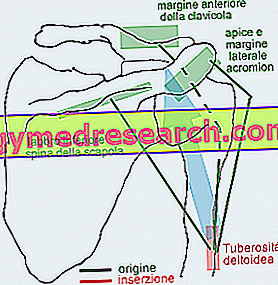(by Roberto Eusebio, absolute national champion of body fitness)
A good percentage of the image of a "beautiful body" is due to the line and the development of the shoulders. In fact, a physique with a well-developed deltoid, but with deficiencies in arms, pectorals or dorsalis, is less perceived as disharmonic with respect to a physique with smaller shoulders and more prominent arms, chest and back.
The deltoid muscle (also called shoulder) is divided into three bundles called: clavicular (anterior), acromial (central) and spinal (posterior).

All three beams fit into the deltoid tuberosity.
The three muscular bundles, which constitute the shoulder, have in part a synergistic action and partly an antagonistic action.
The deltoid is the most important abductor of the humerus and, up to 90 °, only the acromial bundle comes into operation; in addition the clavicular and spinal bundles also come into operation.
The clavicular bundle, partly aided by the acromial bundle, determines an anteversion of the shoulder, while the spinal bundle, always aided by the acromial bundle, determines instead a retroversion of the shoulder.
This has importance in the movements of the arm because the clavicular beam can intraruostarsi the adduced arm and rotated to the outside; while the spinal beam can extrarot the arm if it is rotated inside.
The deltoid clavicle beam also works significantly with pectoral training; the same is true for the spinal bundle that works synergistically with the large dorsal ones. Therefore it is opportune to keep in mind that, in the weekly micro cycle, the training of the deltoids can be combined with the training of the pectorals and of the ridges.

I do the pectoralis major training instead with exercises that stimulate the clavicular deltoid, making frontal risers with a barbell or dumbbell.
The achromial part, on the other hand, which I remember being the portion that also works synergistically with the other two beams, can be inserted in the training of both muscle groups: the chest and the back; for example with a side abduction exercise with dumbbells or cables.
Sometimes I do these exercises several times a week because I have this availability.
But if I had to choose to train the deltoids alone in a single micro cycle, I would develop the training in the way I will now indicate.
I'd start with a multi-joint basic exercise, like a slow back with dumbbells or barbells.

In this basic exercise there is a fairly global fiber impairment; it is therefore necessary to continue the training by working the deltoid beams, as already mentioned above, trying to isolate the work. In particular, for the clavicular bundle: frontal abductions with dumbbells; for the acromial bundle: lateral abductions; finally for the spinal bundle: 90 ° abductions. The shoulder is not a big muscle, but its development, as I have already mentioned, leads to a harmony and a completeness of the shape and the global line of our body.



